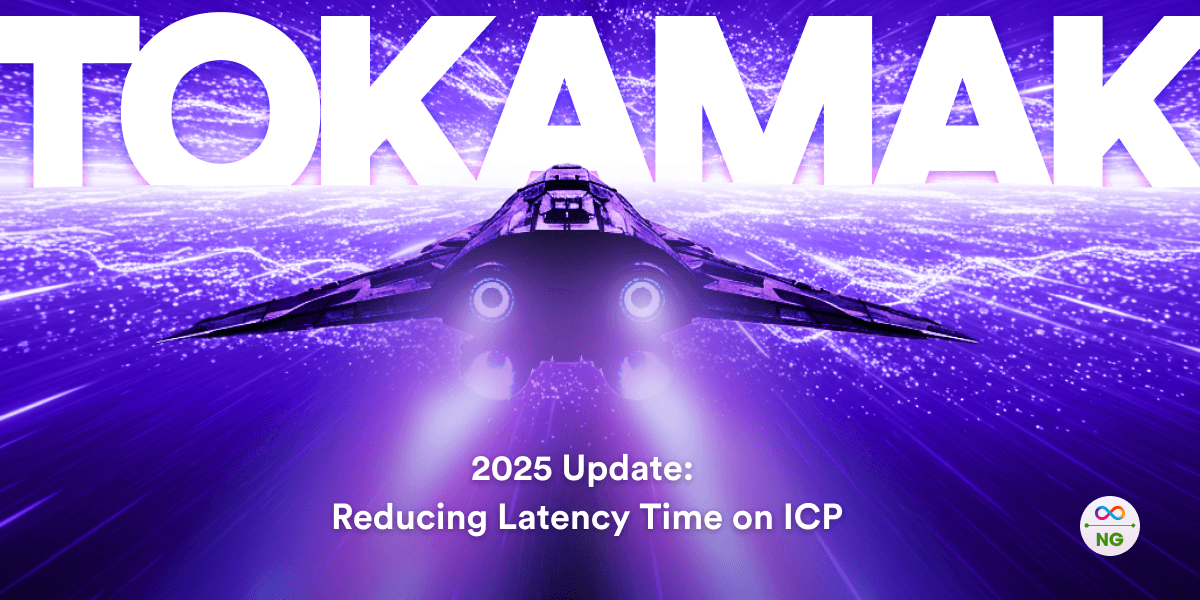
Enabling faster and more responsive applications on the Internet Computer.
One of the most impactful upgrades on ICP came with the Tokamak milestone in late 2024. This was a turning point that addressed longstanding latency challenges and laid the foundation for a more responsive and scalable blockchain infrastructure. As of 2025, the effects of Tokamak are clearer, with developers and users benefiting from reduced delays and a smoother overall experience.
Latency on the Internet Computer Protocol (ICP) refers to the time it takes for a user-initiated action, like calling a smart contract, minting a token, or signing in via Internet Identity, to be fully processed and finalised on-chain.
Latency = the time from when a user initiates a request to when they get a confirmed result on-chain.
This can include:
- Update calls: Actions that change state (e.g., writing data to a smart contract).
- Query calls: Read-only actions (these are faster and don't require consensus).
- Internet Identity authentication: Verifying identity before interacting with apps.
- Cross-canister calls: One canister calling another—this can introduce more delay depending on subnet load.
Pre-Tokamak Latency Issues
Before Tokamak, developers building on the Internet Computer frequently encountered latency-related complaints from users. These delays affected several core actions, such as update calls to smart contracts, identity verification through Internet Identity, and token transfers. Even with ICP’s unique chain-key cryptography and canister-based architecture, inefficiencies persisted.
Key issues included:
- Sub-optimal routing of user traffic via boundary nodes, often sending requests to distant or congested data centers.
- Slower block production rates across various subnets, which meant delays in state changes.
- Bottlenecks in handling ingress messages, which caused inconsistencies in responsiveness.
These challenges not only hampered user experience but also placed limits on what developers could realistically build and scale on the network.
What the Tokamak Milestone Changed
Launched in Q4 2024, the Tokamak milestone was specifically designed to overhaul the way messages and transactions are processed on the network. It implemented a number of behind-the-scenes changes that led to faster execution, lower latency, and a more consistent experience for both end-users and developers.
Core Enhancements:
- Synchronous Ingress Message Execution: Update calls are now processed within the same round they are received, rather than being deferred. This drastically reduces wait times for most front-end interactions.
- Geo-Aware Boundary Node Routing: The boundary node layer now factors in the user’s geographic location, ensuring that requests are sent to the nearest available node. This has improved access speed, especially in regions like Africa and South Asia.
- Faster Block Times on Application Subnets: Block production rates were increased on subnets dedicated to application hosting. This means that changes within apps (such as posting content, updating profiles, or transferring tokens) are confirmed more quickly.
Performance Metrics for Latency Reductions
Following Tokamak, several performance metrics improved significantly across the network:
- ICP Ledger latency improved from an average of 4.57 seconds to 2.23 seconds—over 50% faster.
- Internet Identity (II) operations dropped from 7.12 seconds to 3.9 seconds on average.
- General app canister response times improved from 2.43 seconds to approximately 1.35 seconds.
These improvements translated into a noticeably better user experience. Users could log in, transact, and interact with dapps with less friction, while developers reported fewer errors and retries.
Current Challenges and 2025 Optimizations in Progress
Even with these improvements, some challenges remain in ensuring consistent low-latency performance. Current factors that affect latency include:
- Subnet Overload: Some subnets still experience high traffic, especially from dapps with growing user bases or large token ecosystems.
- Canister Inefficiencies: Developers must still ensure their canisters are well-optimized. Poor memory management or excessive use of inter-canister calls can introduce avoidable delays.
- Boundary Node Availability: As user demand grows, more boundary nodes will need to be strategically deployed to maintain geographic performance parity.
To build on Tokamak's success, several community proposals and upgrades are being explored in 2025:
- Instruction Cost Refinement: Adjusting the way computational effort is measured to reduce unpredictable execution delays.
- Canister Migration Tools: Allowing developers to move smart contracts between subnets to balance traffic more effectively.
- Heartbeat Reduction in DAOs: Finding alternatives to heavy-use heartbeat patterns that slow down governance and protocol apps.
- Automatic Subnet Scaling: Investigating dynamic subnet creation in response to traffic patterns, similar to autoscaling in cloud computing.
Conclusion
The Tokamak milestone didn’t just fix latency, it redefined real-time interaction in a decentralized world. As we move through 2025, the Internet Computer is steadily closing the performance gap with Web2, making blockchain applications fast enough for everyday use.
For developers, this means fewer workarounds and more room for innovation. For users, it means instant logins, responsive interfaces, and trustless transactions that feel seamless. The future of Web3 won’t just be about decentralization—it will be about delivering real-time, real-world performance. And with Tokamak, ICP has taken a major step in that direction.